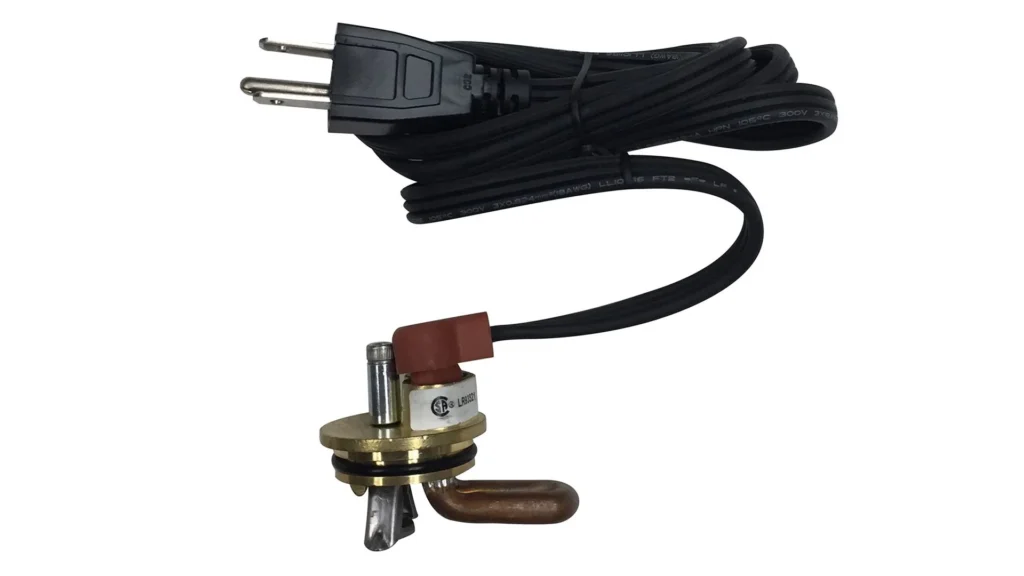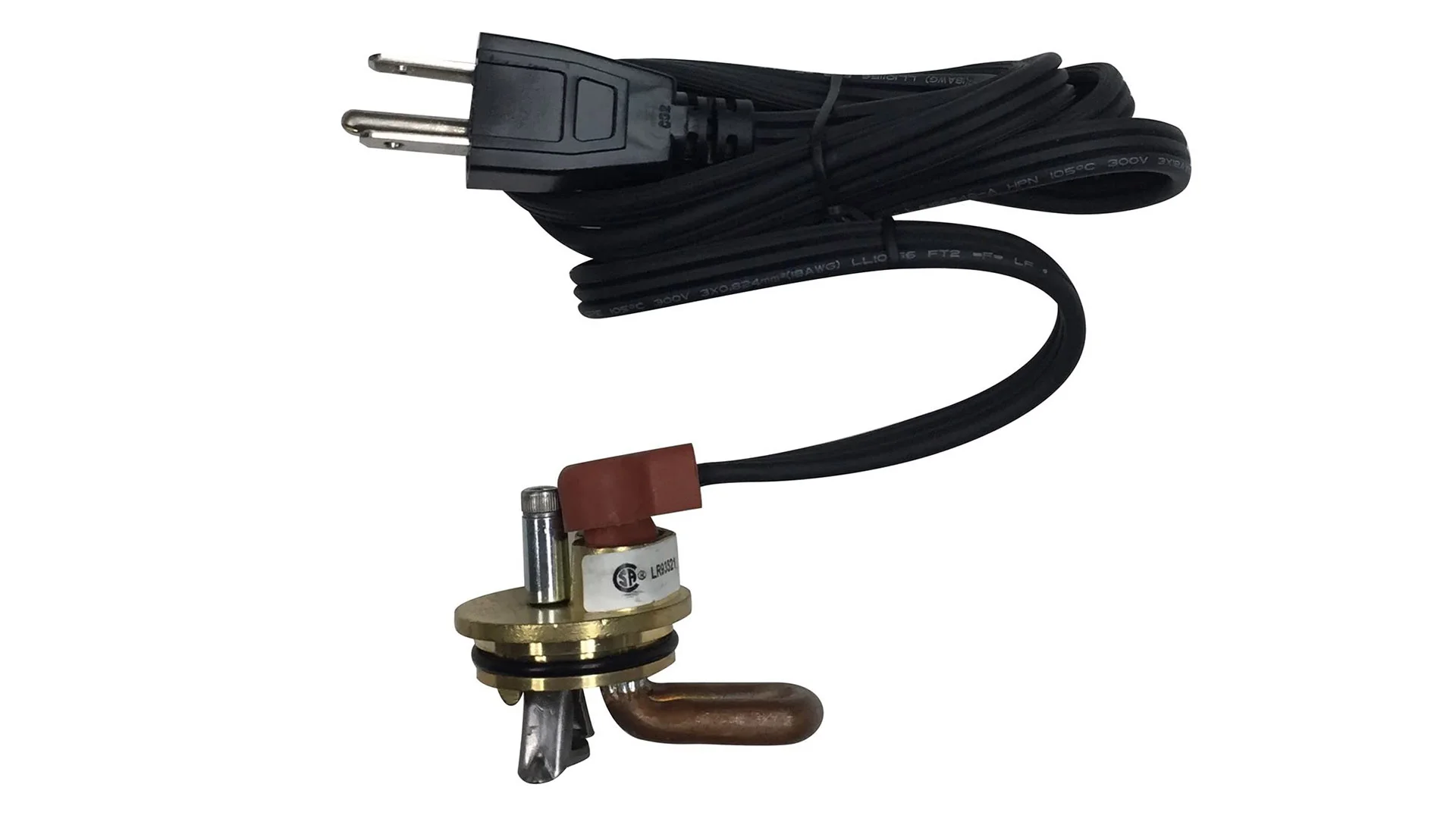Winter’s icy grip is fast approaching, and for those of us living in provinces where sub-zero temperatures are the norm, the question lingers like a frosty breath in the chill air: “Does my car need a block heater during winter?” It’s a question that can make the difference between a smooth, dependable ride and the teeth-chattering frustration of a vehicle during a very cold winter morning.
In this article, we’ll explore their benefits, installation, and cost considerations. So, gear up, because we’re about to embark on a journey that could save you from the winter woes and keep your wheels rolling smoothly through the snow and ice.
What Is A Block Heater?
A block heater is an electrical device designed to keep a vehicle’s engine warm during cold weather conditions, particularly in regions where sub-zero temperatures are common.

It consists of an electric heating element, often made of a heating coil or cartridge, which is inserted directly into the engine’s coolant system. The primary purpose of a block heater is to maintain the engine’s temperature at a level where it can start and operate smoothly, even in extremely cold conditions.
How Does A Block Heater Work?
A block heater is an electrical device designed to keep a vehicle’s engine warm during cold weather conditions. It works by utilizing an electric heating element to warm the engine block and the coolant within it.

Here’s how a block heater typically works:
Installation
The block heater is installed in the engine block, usually by replacing one of the engine’s freeze plugs or through a dedicated port designed for this purpose. The heating element is positioned within the coolant passages of the engine.
Electrical Connection
The block heater is connected to an external power source, typically a standard electrical outlet. It has a power cord that can be plugged into the outlet.
Heating Element Activation
When the block heater is plugged in and receives electrical power, the heating element begins to generate heat.
Heat Transfer
The heating element warms the coolant that flows through the engine’s cooling system. As the coolant circulates, it transfers heat to the engine block, the cylinder walls, and other engine components in contact with it.
Maintaining Engine Temperature
The primary purpose of the block heater is to maintain the engine’s temperature at a level that allows for smooth and reliable starting, even in extremely cold conditions.
The block heater prevents the engine’s temperature from dropping to a level where starting becomes difficult or potentially damaging.
Efficiency and Environmental Benefits
In addition to facilitating easier cold-weather starting, a block heater also improves the overall efficiency of the engine. When the engine is warm, it operates more efficiently, leading to reduced fuel consumption and emissions.
Timer or Thermostat Control
Some block heaters come equipped with timers or thermostats that allow users to schedule when the heater operates or to maintain a specific temperature. This can help conserve energy and ensure the block heater operates only when needed.
In essence, a block heater serves as a preheating system for your vehicle’s engine. It prevents the engine and its components from becoming too cold, ensuring a smoother start and better overall performance, especially in extremely cold weather.
This can be crucial for vehicles operating in regions with harsh winter conditions, as it reduces wear and tear on the engine and provides environmental benefits by improving fuel efficiency and emissions.
RELATED: Why Is The Coolant Reservoir Overflowing? 5 Common Reasons
Does My Car Need a Block Heater During Winter?
Yes, your car may need a block heater during winter, especially if you live in regions with frigid temperatures. A block heater can be a valuable addition to your vehicle, as it helps maintain the engine’s temperature, making cold-weather starts smoother and more reliable.
It also enhances fuel efficiency, reduces wear and tear on the engine, and minimizes emissions during cold starts. Therefore, if you want to ensure your car’s optimal performance and longevity in winter conditions, installing a block heater is a wise choice.
Benefits of Using a Block Heater
Using a block heater during the winter season can offer several significant benefits for your vehicle and your overall driving experience.
Here are the key advantages of using a block heater:
- Improved Cold-Weather Starting: Block heaters pre-warm the engine and its components, ensuring a smoother and quicker start in cold weather. This reduces the strain on the battery and starter motor, which can be especially helpful in extremely low temperatures.
- Reduced Engine Wear and Tear: Cold starts can cause increased engine wear due to the thickening of oil and other fluids. Block heaters minimize this wear and help extend the lifespan of your engine.
- Enhanced Fuel Efficiency: A warm engine operates more efficiently. By using a block heater, you can improve your vehicle’s fuel efficiency during the winter months, potentially saving on fuel costs.
- Lower Emissions: Improved engine efficiency and reduced idling time result in lower emissions during cold starts. Using a block heater contributes to a cleaner and more environmentally friendly driving experience.
- Consistent Cabin Heating: With the engine warmed up, your car’s heating system can produce warm air more quickly, ensuring that you stay comfortable inside the vehicle from the moment you start driving.
- Faster Defrosting: A pre-warmed engine helps the defrosting process by providing heat to the windshield and windows. This means better visibility and safer driving conditions.
- Extended Battery Life: The reduced strain on the battery during cold starts can lead to a longer battery lifespan, saving you from the hassle and cost of frequent battery replacements.
- Reliable Engine Performance: Using a block heater ensures that your vehicle performs reliably even in the harshest winter conditions, reducing the risk of breakdowns and inconvenient situations.
- Peace of Mind: Knowing that your vehicle is ready to start and operate smoothly on cold mornings can provide peace of mind and reduce the stress associated with winter driving.
- Engine Longevity: By minimizing the stress and wear associated with cold starts, a block heater can contribute to the long-term health and longevity of your engine.
How Much Does A Block Heater Cost?
The cost of a block heater typically ranges from $175 to $250, depending on various factors such as the make and model of your vehicle, the complexity of installation, and the region where you live.
It’s essential to consider both the purchase price of the block heater itself and any installation fees, as professional installation may be required for some vehicles.
Keep in mind that while the initial cost may seem like an investment, the benefits of improved engine performance, fuel efficiency, and reduced wear and tear can make it a worthwhile expense, especially in cold winter climates.
Signs Your Car Might Need a Block Heater
Here are some common signs that indicate your vehicle may need a block heater:
- Difficulty Starting in Cold Weather: If your car struggles to start, especially on frigid mornings, it’s a clear sign that the engine may be too cold. A block heater can make cold-weather starts much smoother.
- Engine Misfires or Rough Idling: Extremely cold temperatures can cause fuel combustion issues, leading to engine misfires or rough idling. A block heater can help maintain optimal engine temperature and reduce these problems.
- Reduced Fuel Efficiency: In cold weather, the engine takes longer to reach its ideal operating temperature, leading to reduced fuel efficiency. If you notice a significant drop in mileage during winter, a block heater can help.
- Unresponsive Heater: If your vehicle’s cabin heater takes an unusually long time to warm up or doesn’t provide sufficient heat, it could be due to a cold engine. Using a block heater can help the heater system work more effectively.
- Increased Exhaust Smoke: Cold starts can result in excessive exhaust smoke, which may be due to incomplete combustion. A block heater can reduce the amount of smoke emitted during startup.
- Engine Knocking or Pinging: Cold weather can cause engine knocking or pinging noises due to inefficient combustion. A block heater can improve combustion efficiency and reduce these noises.
- Oil Thickening: Cold temperatures can cause engine oil to thicken, making it harder for the engine to lubricate properly. If you notice increased engine noise or decreased oil pressure during cold starts, a block heater can help maintain proper oil viscosity.
- Battery Strain: Cold starts put additional strain on the vehicle’s battery, which can lead to reduced battery life. If you’ve had frequent battery issues in cold weather, using a block heater can alleviate this stress.
- Environmental Concerns: If you’re environmentally conscious and wish to reduce the emissions associated with cold starts, a block heater can help lower emissions by improving engine efficiency.
- Longer Warm-Up Times: If your vehicle typically takes an extended period to warm up during winter, it can be inconvenient and inefficient. A block heater can reduce warm-up times, providing faster access to a comfortable cabin temperature.
If you observe one or more of these signs, it’s a good indication that a block heater could be a valuable addition to your vehicle, especially if you live in an area with harsh winter weather.
Installing a block heater can improve your car’s performance, extend its longevity, and enhance your overall winter driving experience.
RELATED: A Comprehensive Guide to Buying and Using a 2021 Hyundai Venue in Canada
DIY Tips For Installing and Using a Block Heater
Installing and using a block heater can be a do-it-yourself (DIY) project for those who are comfortable working on their vehicles. Here are some DIY tips for installing and using a block heater:
Installation
Gather the Necessary Tools
Before you begin, make sure you have all the tools and materials you’ll need, including a block heater kit designed for your specific vehicle, a socket set, a torque wrench, a cord protector, and electrical tape.
Read the Instructions
Carefully read the installation instructions provided with the block heater kit. Familiarize yourself with the steps and any specific requirements for your vehicle.
Choose the Right Location
Select a suitable location on your engine block to install the block heater. This is typically in a freeze plug port or a dedicated hole provided by the manufacturer. Ensure it’s easily accessible and not obstructed by other components.
Drain Engine Coolant (if necessary)
If your installation location requires it, drain some engine coolant to prevent spillage during installation.
Install the Block Heater
Insert the block heater into the chosen location, following the kit instructions carefully. Use a torque wrench to tighten it to the specified torque value to avoid over-tightening.
Connect the Cord
Route the block heater cord to a location where you can safely plug it into an electrical outlet. Use a cord protector to secure the cord and protect it from damage.
Seal and Secure the Cord
Seal any gaps around the cord entry point with electrical tape to prevent moisture from entering the engine bay. Ensure the cord is securely fastened to prevent it from coming into contact with moving parts.
Test the Heater
Before using the block heater, perform a test to ensure it’s working correctly. Plug it in and check for any visible signs of heat or warmth from the heating element.
Usage
- Follow Safety Guidelines: Always follow the safety guidelines provided with the block heater, including not using damaged cords, plugging it into a grounded outlet, and avoiding contact with water.
- Set a Timer (optional): To conserve energy, consider using a timer to turn on the block heater a few hours before you plan to start your vehicle. This ensures your engine is sufficiently warm without unnecessary electricity consumption.
- Plan Your Preheating: Determine how long your vehicle needs to be plugged in based on the temperature and your vehicle’s specific requirements. Some vehicles may require longer preheating in extremely cold conditions.
- Unplug Before Driving: Remember to unplug the block heater before starting and driving your vehicle. Leaving it plugged in while driving can damage the heater and pose a safety risk.
- Monitor Temperature: Consider using a thermometer or a smart plug with temperature monitoring capabilities to ensure your engine reaches the desired temperature before you start your car.
- Be Mindful of Electricity Costs: While block heaters are energy-efficient, be mindful of your electricity usage, especially if you’re using the heater frequently.
If you’re not sure about any aspect of the installation, it’s always a good idea to consult your vehicle’s manual or seek professional assistance to ensure a safe and proper installation.
FAQ
1. Do you need a block heater in the winter?
In regions with extremely cold winters, a block heater can be highly beneficial. It helps maintain your engine’s temperature, making it easier to start and reducing wear and tear on cold mornings. While it’s not an absolute necessity for all areas, it’s a valuable addition in cold climates.
2. At what temperature do you need an engine block heater?
Block heaters are most beneficial in temperatures below freezing (32°F or 0°C) and particularly crucial in extremely cold conditions, typically below 20°F (-6.7°C). However, using a block heater at temperatures above freezing can still offer advantages in terms of improved engine performance and efficiency.
3. What happens if you don’t have a block heater?
Without a block heater in very cold weather, your engine may struggle to start due to thickened fluids and increased internal resistance. This can lead to battery strain, increased wear on engine components, and reduced fuel efficiency.
4. Will my car start without a block heater?
Yes, your car can start without a block heater, especially in milder winter conditions. However, in extremely cold temperatures, starting your car may be more difficult, and it can put additional strain on the engine and battery.
5. Is a block heater necessary?
Whether a block heater is necessary depends on your location and the severity of winter temperatures. In extremely cold regions, it is highly recommended for smoother starts, improved engine performance, and reduced wear. In milder climates, it may not be essential but can still offer benefits.
6. Does a block heater keep the engine warm?
Yes, a block heater keeps the engine warm by heating the coolant and components in the engine block. This helps maintain a warmer operating temperature, making it easier for the engine to start and operate efficiently in cold conditions.
Conclusion
A block heater can be a valuable asset during winter, improving your car’s performance, reducing wear and tear, and enhancing your overall driving experience in cold weather.
If you install and use it correctly, you can ensure smoother starts, better fuel efficiency, and a more reliable vehicle, making winter driving more manageable. Consider this simple addition to your vehicle as a proactive measure to tackle the challenges of winter weather with confidence.




